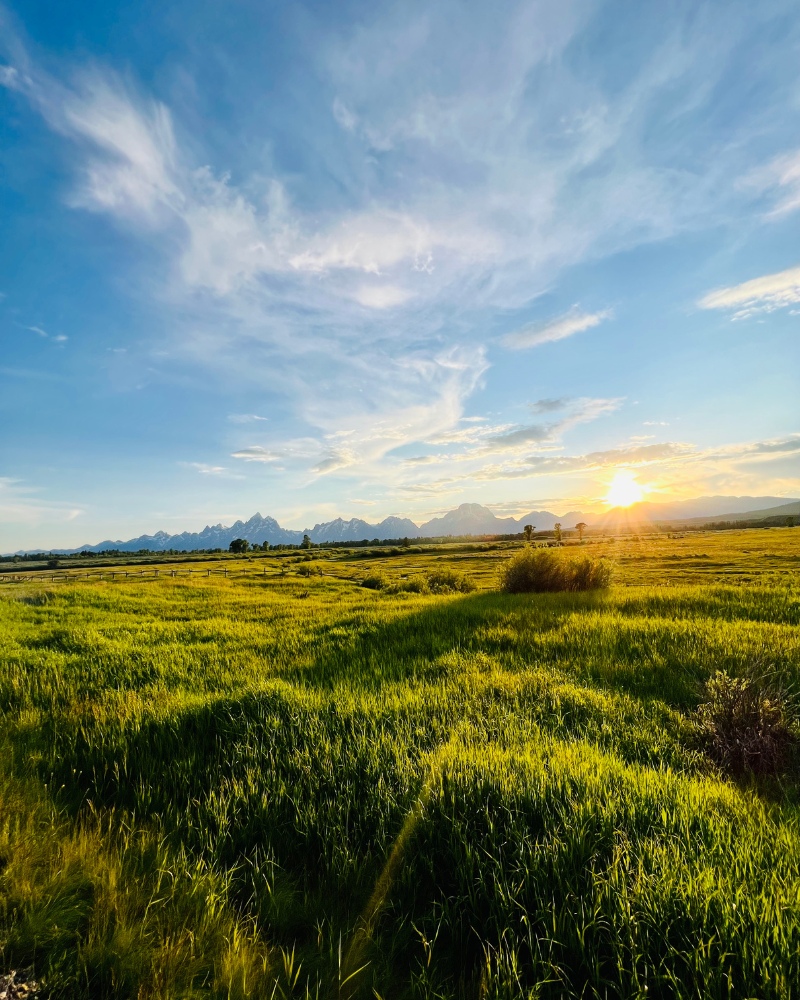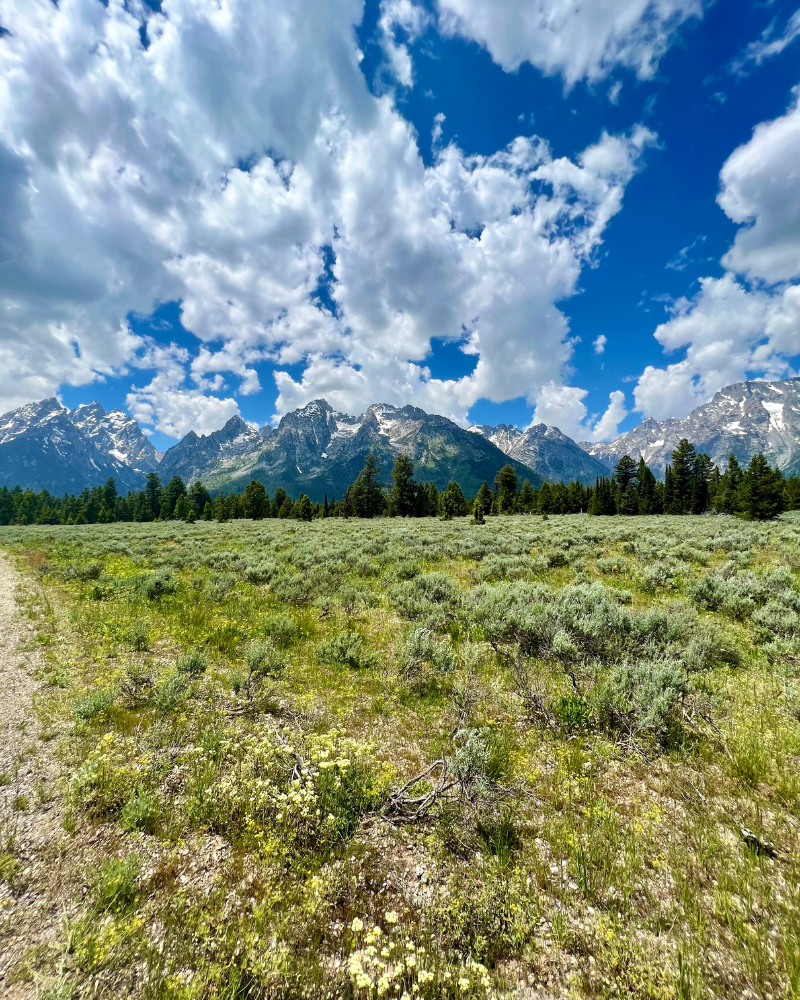The First Timer’s Guide To The Grand Tetons
The Grand Tetons, located in northwestern Wyoming, have towering peaks, beautiful alpine lakes, and lush valleys. Whether you are a big hiker, a wildlife lover, or someone looking for a relaxing experience, the Grand Tetons offer something for everyone.
Established in 1929, the park spans over 300,000 acres, providing a protected haven for the region's diverse ecosystems. Aside from hiking, you can explore the park through scenic drives, boat excursions on Jenny Lake, and ranger-led tours.
My husband and I experienced the Grand Tetons on a road trip. We started in Boise then headed to Big Sky, Yellowstone, and ended with a weekend in Jackson. I absolutely loved the Grand Tetons. Even if you’re not a hiker, you could spend all day driving around and enjoying the scenery.
The First Timer’s Guide To The Grand Tetons
Getting There
Jackson Hole Airport (JAC) is the best airport to fly into, and is a quick drive from the park's entrance. The town of Jackson, located near the park, is a convenient hub for lodging ad dining. If you’re not staying in the park, Jackson is a great place to stay.
Getting Around
You’ll definitely want (and need) to rent a car if you aren’t driving to the park. Some hikes are easy to get to by foot, but the park is pretty big. So if you plan on exploring different areas, you’ll want to get there by car.
Best Time Of Year To Go
The best time to visit the Grand Tetons depends on personal preferences and the type of experience you’re looking to have.
June to August is the most popular time to visit. More trails are open during this time, and the scenery is in full bloom. It’s also the perfect time if you’re looking to do any water activities on Jenny Lake.
September to October has gorgeous autumn colors and the wildlife is a little more active.
December to February, everything is covered ins now, and it’s the perfect time to experience the winter activities.
Where To Stay
Lodges and Hotels Inside the Park
Jenny Lake Lodge: A historic and upscale option, close to Jenny Lake. Reservations are highly recommended.
Jackson Lake Lodge: Near Jackson Lake with gorgeous views of the Grand Tetons.
Lodges and Cabins Outside the Park
Signal Mountain Lodge: Near Jackson Lake and has some cabins with lake views.
Colter Bay Village: A more rustic option with cabins and campsites.
Downtown Jackson
The town of Jackson, located near the park's entrance, has a variety of hotels, inns, and bed and breakfasts. This is the best option if you’re looking to experience Jackson and take day trips to the Grand Tetons.
Camping
Grand Teton National Park Campgrounds: If you’re looking for a more immersive (and super cool) experience, camping within the park is the route to go. The most popular campgrounds are Jenny Lake, Signal Mountain, and Gros Ventre. Be sure to make reservations ahead of time, especially during peak seasons.
Backcountry Camping: If you’re feeling adventerous, backcountry camping permits are available. Just keep in mind that these require careful planning and attention to park regulations.
Jackson Hole Ski Resorts (Winter)
If you're visiting during the winter for skiing or snowboarding, you’ll want to consider staying at one of the ski resorts in Jackson Hole, like Teton Village.
RV Parks
If you're traveling in an RV, there are RV parks inside and outside the park that offer hookups and facilities.
Hikes
The Grand Tetons are a hiker’s paradise. There are gorgeous trails that wind through the range. What’s great is that there are hikes for every level - and all have stunning views. Here are some of the most popular hikes:
Cascade Canyon Trail
Difficulty: Moderate
Distance: ~9 miles round trip
Highlights: Beginning at Jenny Lake, the Cascade Canyon Trail is a classic Teton hike. As you climb, you'll see stunning views of Hidden Falls and Inspiration Point. The trail then continues into the heart of Cascade Canyon, surrounded by towering peaks on either side. Keep an eye out for wildlife, including moose and black bears.
Delta Lake Trail
Difficulty: Difficult
Distance: ~8 miles round trip
Highlights: If you’re up for a challenge, the Delta Lake Trail is the perfect option. The trail takes you through lush forests and open meadows before reaching the stunning, turquoise Delta Lake, situated beneath the Grand Teton.
Taggart and Bradley Lakes Loop
Difficulty: Easy to Moderate
Distance: ~5 miles loop
Highlights: This family-friendly loop is a perfect introduction to the Grand Tetons. Beginning at the Taggart Lake Trailhead, the path winds through meadows with a backdrop of the Teton Range. It’s like something out of a postcard!
Amphitheater Lake Trail
Difficulty: Difficult
Distance: ~10 miles round trip
Highlights: This challenging trail takes you to the glacial-fed Amphitheater Lake, surrounded by steep cliffs and breathtaking mountain vistas. As you ascend, the views become increasingly dramatic, with a gorgeous payoff at the lake. Keep an eye out for bighorn sheep along the way!
Paintbrush Canyon and Cascade Canyon Loop
Difficulty: Difficult
Distance: ~19 miles loop
Highlights: For any ambitious hikers, you’ll want to try the Paintbrush Canyon and Cascade Canyon Loop. This loop takes you through high alpine meadows, past stunning lakes, and provides panoramic views of the Tetons. You’ll definitely want to plan for a full day on the trail to enjoy every part of this epic hike.
Death Canyon Trail
Difficulty: Moderate to Difficult
Distance: ~8 miles round trip
Highlights: Despite its name, Death Canyon is a beautiful trail. The trail winds through forests, opens up to large meadows, and ends at Phelps Lake, a perfect spot to relax.
Know Before You Go
Weather: Be prepared for fluctuating weather conditions. Summers can be warm during the day, but temperatures can drop at night. Winters bring cold temperatures and heavy snowfall, while spring and fall can be a little more unpredictable.
Altitude Awareness: The Grand Tetons are at a high elevation, so altitude sickness is a possibility. Pay attention to how you’re feeling and take it easy if you start to feel any sort of symptoms.
Wildlife: The park is home to a variety of wildlife, including bears, moose, and elk. Be knowledgeable about wildlife safety, carry bear spray when hiking, and keep a safe distance when observing animals.
Trail Conditions: Trail conditions can vary depending on the season. Be sure to check for trail closures, snowpack, and weather conditions before starting your hikes. Some trails also might be closed during certain times for wildlife protection.
Permit Requirements: If you plan on backcountry camping, you’ll need to get the necessary permits. Popular trails and campsites can fill up quickly, so you’ll want to plan and make reservations in advance.
Camping Options: There are several campgrounds within the park, ranging from very basic sites to sites with more amenities. Do your research and find the best campsite for you.
Park Entrance Fees: The Grand Tetons National Park has an entrance fee, which grants you access for 1-7 days. Be sure to keep your receipt! Otherwise, you will have to pay for another pass.
Seasonal Services: Services and facilities within the park may vary depending on the season. Some visitor centers, lodges, and restaurants might be closed during the off-season, so plan accordingly.
Cell Service: Parts of the Grand Tetons have very limited or no cellular reception. More often than not, you will not have any service. Make sure you make any necessary maps available offline and plan accordingly.
What To Pack
Clothes
Lightweight clothes for warm days
Layers for cooler temperatures, especially in the evenings
Sturdy hiking shoes or boots
Hat, sunglasses, and sunscreen
Daypack/backpack for carrying essentials like water and snacks during hikes
Weather-Specific Items
Warm gloves and a hat
Waterproof and/or windproof jacket, in case of rain
Umbrella or rain poncho in case of rain
Backpack rain cover or waterproof pack liner
Other
Insect repellent: You will absolutely want this! There are a lot of mosquitos and bugs, especially around the lakes
Park Pass: Grand Tetons National Park pass or America the Beautiful pass
Cash: For park fees or purchases in areas that don’t accept credit cards
External Phone Charger: Since service is limited, your phone battery might not hold its charge as long. You’ll want to bring an external phone charger, especially if you’re using your phone as a camera!
Bear spray: We bought some bear spray, and didn’t end up using it. It’s expensive, so I would recommend renting it from the airport if you’re flying into the Jackson Hole Airport
Any necessary camping gear, if applicable
Enjoy your trip!
*This post is not affiliated with any of the mentioned establishments.





